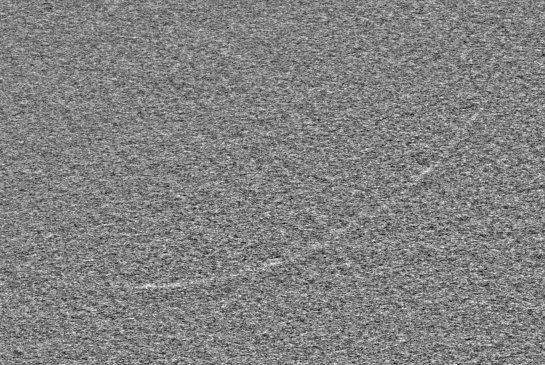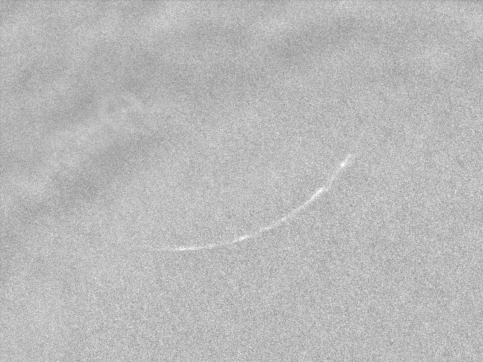August 19, 2017
Extreme Crescents
Originally published January 31, 2008

image by Martin Elsässer The Moon at 5.0° elongation from the Sun, 3 hours 27 minutes after New Moon.
Thin lunar crescents are hard to see, and the closer the Moon is to the Sun, the harder they are to see. In the 1930's the French astronomer André Danjon noticed that not only does the crescent get thinner and dimmer, but the length of the crescent appears to decrease as well. Danjon interpreted this as an effect related to the roughness of the lunar terrain: it was if the shadowed side had a larger diameter than would be expected for a smooth sphere, and this added ring of darkness ate first into the horns of the crescent and then into the crescent itself. By plotting all the visual observations he could find, he concluded that the length of the crescent should go to zero -- that is, the crescent should vanish entirely -- whenever the Moon is seen closer than about 7° from the Sun. But it has never been clear if this widely quoted "Danjon Limit" is truly an intrinsic property of the Moon or merely a statement of the limited ability of our eyes to perceive a thread-like streak of light against the increasingly bright twilight sky in which the thinnest crescents are typically viewed. Early observations from rockets sent above the Earth's atmosphere suggested that the problem was largely perceptual: vestiges of a crescent could reportedly be photographed at "elongations" from the Sun of as little as 2°. But little has been heard since about the visibility of thin lunar crescents from space.
Now Martin Elsässer and friends have begun exploring a new technique for determining from Earth what the Moon really looks like under these extreme crescent conditions. Trekking from their Munich home to the clear skies of the nearby Austrian peaks, using a baffle to block direct sunlight from their telescope, and imaging in the infrared (where the intensity from the blue-scattering mountain sky is lowest), they have not only been able to find lunar crescents at mid-day, but to see them much closer to the Sun than has ever been done before from Earth. Unlike the conventional twilight crescent observations at visible wavelengths, in which the thin crescent is only visible when the Sun is below the horizon, and fades from view as the Sun rises; observations by this new technique are actually helped by the Sun and Moon being as high in the sky as possible, where conditions are likely to be most clear -- and thin crescents, if present, can be observed all day! The extreme crescent shown above clearly demonstrates that the crescent does not actually disappear. The elongation here was just 5.0°, much below the Danjon Limit, yet with careful image processing Martin was able to tease his prize from the background noise under less than ideal conditions -- the Moon was only 35° above the horizon. The one below (elongation 5.2°) is slightly clearer, in part, because, 45 minutes later, the Moon had climbed into the clearer air a little higher above the horizon.
Because in some months the Moon is always 5° or more from the Sun (even when "New"), it's clear from Martin's work that an infrared-eyed observer might never entirely lose sight of the slender crescent. Martin is telling us not only that the true limit of lunar illumination is not where Danjon put it, but also that we are going to have to rethink what we mean by things like "the first sighting of the New Moon".

The Moon at 5.2° elongation from the Sun, 4 hours 11 minutes after New Moon.
Editor's note: This description of Martin's work was supplied by the-Moon Wiki member Jim Mosher. Chuck Wood will be back tomorrow.
Technical Details
- Telescope: 2"-Refractor (800 mm FL) IR-Pass + Solar Continuum-Filter
- Camera: Sigma 6303, 4 sec exposures
- Observing Site: Stuhleck, Austria (15.79111°E, 47.57472°N, 1782 m)
- Date/time: June 15, 2007; 6:34-6:45 UT (top, sum of 14 images), 7:08-7:40 UT (bottom, sum of 84 images)
- Images oriented with North Celestial Pole up, image scale 2.31 arc-seconds per pixel (top), 4.62 arc-seconds per pixel (bottom)
- Please note that in most cases the infrared crescents are very difficult to see in the original raw images, and that a considerable amount of processing is required to make them visible
Related Links
- Martin's website (including his Extreme Crescents page)
- Martin's current record-breaking faint crescent at 4.75° elongation, 2hours 41 minutes after New Moon (see end of page)
- The Islamic Crescents' Observation Project (a fine compendium of twilight crescent sightings from around the world, updated monthly)
- Details of two world record visual sightings (at about 7.5° elongation)
- Sky and Telescope's Seeking Thin Crescent Moons
- Robert van Gent's bibliography of literature related to lunar crescent visibility
- Related LPOD's: Almost Nothing When Maria are Bright Seeking Illumination
Yesterday's LPOD: Evidence for a Lunar Tsunami
Tomorrow's LPOD: Things That Go Bump in the Night
COMMENTS?
Register, Log in, and join in the comments.



